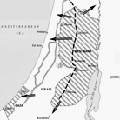|
作者:潔西卡•麥卡琳
伊朗、伊拉克和沙烏地阿拉伯豐富的石油蘊藏量,使得中東地區遭受許多因地緣政治引發的戰爭。但如何獲得水這更基本的資源,才是以色列人和巴勒斯坦人之間激烈衝突的根源。
目前重要的實例:巴勒斯坦人最近拒絕了以色列提出的和平方案,原因之一是,這份方案並未給予巴勒斯坦人在自己土地上的水資源管理權。中東和平進程進行不順,其中的原因難以釐清,不僅僅因為其中牽涉了諸多議題;不過,如果我們透過放大鏡,仔細觀察這其中與水資源有關的議題,可以發現巴勒斯坦人似乎有道理。

一年輕的男孩從供給村莊用水的卡車提水。
以色列和巴勒斯坦分用的這塊土地,不是沙漠就是雨量稀少,所以,如果要讓當地每個人都有足夠的水來維持相當好的生活水準,就必須謹慎地分配使用有限的水。根據國際法的規定,本區大部分的水都屬於國際資源,因此,應該在合理與公平的原則下,由以色列與巴勒斯坦共享。
但不幸的,「公平」與「合理」兩個字,並不能用來形容目前以色列和巴勒斯坦之間用水的情況。
目前,每個以色列人得到的水量是巴勒斯坦人的5倍,在加薩地區這種不均衡的情況更嚴重:以色列移民得到的水是其巴勒斯坦鄰居的七倍。換句話說,在約旦河西岸,每個以色列人平均每天得到92.5加侖的水,巴勒斯坦人每天只有18.5加侖。美國國際發展局及世界衛生組織建議,在家庭和在都市裡,每人每天最少的用水是26.4加侖。
區隔與不均
來自「以色列佔領區人權資料中心(B'Tselem)」的萊恩(Yehezkel Lein),簡要地解釋了這種不均現象的起因:「以色列在佔領區所實行的基本水資源政策就是,盡量維持供水量來滿足以色列人民的需求。」

本區水資源分布的地理位置。點選看更大的圖片。(地圖來源:聯合國政治事務部。)
萊恩說,這項水資源政策利用許多不同的作法來達成。首先,以色列對於在佔領前就有的地下水分配的不公平現象,將這種情形變成正式的官方作為:以色列限制巴勒斯坦人的用水量,禁止開鑿新水井,並且限定已開鑿水井的的取水量。之後,以色列著手開發在1967年「六日戰爭」之前沒有控制到的水資源,例如那位於西岸的東部地下水層(Eastern Aquifer)和加薩地下水層(Gaza Aquifer)。以色列從佔領區獲得新的水資源,主要施惠於以色列移民,儘管這些移民都是違法的。(根據國際法,約旦河西岸和加薩走廊屬於佔領區,受到日內瓦公約中有關戰爭的法律所約束,公約明白表示佔領國-以色列-不可以讓人民遷移到被佔領的國家-巴勒斯坦-境內。)(編按:1967年「六日戰爭」,以色列佔領了巴勒斯坦境內約旦河西岸地區。)
以色列的確將一些巴勒斯坦鄉鎮區域納入他們的供水系統中,儘管仍有將近30%的巴勒斯坦家庭仍未被納入;不過根據B'Tselem的資料,以色列並沒有提供適當的管線維護,所以供應給巴勒斯坦鄉鎮的水有一半從管線中流失了。再者,以色列當局給予以色列人及其移民優先的用水權:在夏天缺水時,以色列的自來水公司Mekorot會關閉供給巴勒斯坦鄉鎮的主要水管的閥門,這樣以色列的正常供水才不會受到影響。
以色列與巴勒斯坦當局,雙方於1995年簽署了「奧斯陸和平進程」,該文中規定,不減少以色列從約旦河西岸含水層的取水量,巴勒斯坦人所增加的用水需求則必須去找新的水源來因應,而不是將現有的水源重新分配。但是,以色列擁有開發新水資源計畫的否決權,到現在已經六年過去了,以色列一直運用這項否決權阻止或拖延幾乎所有的相關計畫。

約旦河西岸一景:我的山谷有多乾燥呢?(照片提供 耶路薩冷水公司。)
從2000年9月反對以色列佔領的暴動發生以來,雙方之間的緊張程度不斷升高,同時,巴勒斯坦的缺水問題也日益嚴重,特別是那些未曾接通供水系統的鄉鎮地區。而以色列採取的封鎖政策-以戰車與士兵封鎖巴勒斯坦鄉鎮與山谷的出入口,阻礙一般的交通,使得村民到鄰近水井打水與水車進入村莊送水變得危險且困難重重。
人權組織一致譴責這些政策,指出這違反了人權法中所列的基本生存需求(如得到健康與適當的生活必需品的權利),並且違反國際法的基本精神(如禁止使用佔領區的物資及禁止不公平的供水)。
這些組織也指出,以色列的水資源政策會使得政治上的憤恨升高,最後只會讓和平協議更難達成。如果各種的雙方協議都沒有包含能公平解決水資源問題的方案,那麼,將沒有任何協議可以被達成。
【文章連載】
■血與水I 血與水II
(上)
全文與圖片詳見: http://www.gristmagazine.com/grist/main
dish/mccallin022602.asp
版權歸屬 Earth Day Network,環境資訊協會(龐中培 譯,李欣哲 審校)
中英對照全文:http://e-info.org.tw/issue/water/2002/
wa02041501.htm
|
|
by Jessica McCallin,26 Feb 2002
Oil, namely the vast reserves in Iran, Iraq, and Saudi Arabia, is the cause of many of the broad geopolitical battles plaguing the Middle East. But it is access to water, a more fundamental resource, that is at the root of much of the bitter conflict between the Israelis and the Palestinians.
Case in point: The Palestinians say they rejected a recent peace proposal from Israel because, among other things, it didn't give them control of water resources within their territory. Granted, it's tough to figure out what's to blame for the unravelling of the Middle East peace process, not least because there are so many issues on the table. But when viewed through the lens of one of those issues -- access to water -- the Palestinians seem to have a point.

A young boy gets water from one of the trucks supplying villages.
The land that Israel and Palestine share is desert or semi-arid, so the limited amount of water in the area must be carefully managed if everyone is to get enough to ensure a decent standard of living. International law states that most of the water sources in the area are international resources, and as such must be shared by Israelis and Palestinians according to the principle of equitable and reasonable use.
Unfortunately, equitable and reasonable are two words that cannot be used to describe the water situation in Israel and Palestine.
At present, Israelis receive five times as much water per person as Palestinians. In Gaza, the disparity is even more striking, with settlers getting seven times as much water as their Palestinian neighbors. Stated differently, on average, Israelis get 92.5 gallons per person per day, while Palestinians in the West Bank get 18.5 gallons per person per day. The minimum quantity of water recommended by the U.S. Agency for International Development and the World Health Organization for household and urban use alone is 26.4 gallons per person per day.
Separate and Unequal
Yehezkel Lein from B'Tselem, the Israeli Information Center for Human Rights in the Occupied Territories, explains the origins of this discrepancy succinctly: "Underlying Israel's water policy in the Occupied Territories was the desire to preserve the quantity of water it uses."

Where the water is. (Click here for a larger map.) Map: U.N. Department of Political Affairs.
Lein says a variety of methods were used to achieve this. First, Israel formalized the unequal division of the shared groundwater that was established prior to the occupation: capping Palestinian consumption, banning the digging of new wells, and putting quotas on how much water could be extracted from existing wells. Then it set about exploiting new water resources it didn't control before the 1967 War, such as the Eastern Aquifer in the West Bank and the Gaza Aquifer. These new water resources primarily benefit the Israeli settlements that are still being established in those areas -- even though those settlements are illegal. (Under international law, the West Bank and the Gaza Strip are defined as occupied territories and are therefore subject to the Geneva Conventions on the laws of war. The convention expressly prohibits moving people from the occupying county, i.e. Israel, into the occupied country, i.e. Palestine.)
Israel did hook some Palestinian towns into the water network -- although nearly 30 percent of Palestinian homes have yet to be connected -- but it did not provide appropriate maintenance work, with the result that, today, as much as half of the water meant to supply some Palestinian towns may be lost to leaking pipes, according to B'Tselem. The country also gave Israelis and settlers priority access to water: In the summer, when water is scare, the Israeli water company Mekorot shuts the valves of the main pipelines supplying Palestinian towns so that Israeli supplies remain unaffected.
The interim agreement of the Oslo peace process, signed by Israel and the Palestinian Authority in 1995, mandated zero reduction in the amount of water Israel was allowed to extract from the West Bank aquifers. Any additional water that the Palestinians needed was to come from new sources, not from a redistribution of existing sources. Israel, however, was given a veto on any water project aimed at tapping new sources and, over the past six years, has used that veto to block or delay almost all proposed projects.

A snapshot of the West Bank: How dry was my valley?
Photo: Jerusalem Water Undertaking.
When tensions between the two sides run high, as they have since September 2000 when the current uprising against the occupation started, the Palestinian water crisis becomes more desperate, especially for those without a connection to the water network. The Israeli policy of closure -- whereby tanks and soldiers block entrances to Palestinian towns and villages, disrupting the normal flow of people and traffic -- makes it difficult and dangerous for villagers to go to nearby wells and for water tankers to get into villages.
Human rights organizations are unanimous in condemning these policies, pointing out that they violate fundamental tenets of human rights law (such as the right to good health and an adequate subsistence) as well as fundamental tenets of international law (such as the ban on using resources from occupied territory and the ban on distributing water in a discriminatory way).
Such organizations also point out that Israel's water policy heightens political resentment and, ultimately, makes reaching any peace agreement more difficult. No such agreement will be struck that does not entail a just resolution to the water issue.
http://www.gristmagazine.com/grist/main
dish/mccallin022602.asp
|
